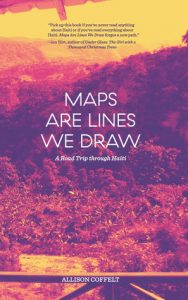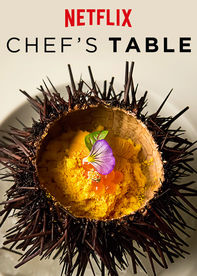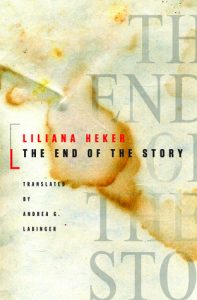 What does it mean to leave no trace? This laudable goal of many a traveler can go awry when we get caught up in the “what does it mean” and forget that “leave no trace” is meant to apply to the outer environment and not to ourselves. In reading Maps Are Lines We Draw: A Road Trip through Haiti, I have no doubt that Haiti left traces on Allison Coffelt’s heart and soul, but the book gets caught up enough in the headiness of her experience that I too often missed what the journey felt like. Worse, I missed the opportunity to feel myself transformed by her journey.
What does it mean to leave no trace? This laudable goal of many a traveler can go awry when we get caught up in the “what does it mean” and forget that “leave no trace” is meant to apply to the outer environment and not to ourselves. In reading Maps Are Lines We Draw: A Road Trip through Haiti, I have no doubt that Haiti left traces on Allison Coffelt’s heart and soul, but the book gets caught up enough in the headiness of her experience that I too often missed what the journey felt like. Worse, I missed the opportunity to feel myself transformed by her journey.
To be fair, much of Coffelt’s most obvious travel transformations probably happened before she even left home when she read Tracy Kidder’s Mountains Beyond Mountains, the book that inspired Coffelt’s trip and in the international journeys she undertook before this one. And I deeply appreciate that she was trying to give us a more complex experience than the standard “I went abroad, I saw a lifestyle unlike my own, I was transformed” trope, but the fact that she’s visibly still processing this complex experience makes it harder to follow along with her, as does the fact that we are exposed as much to her thoughts about events (or even her thoughts on thinking about events) as we are to events themselves.
Scene vs. Summary
One of the lessons drilled into me in an early writing class is that readers need scene (the depiction of events) in order to engage with events rather than summary (the narration of outcomes) which can keep a reader on the outside of a story. It’s a lesson I rebelled against (like most lessons) and we can all cite examples of long, in-depth narrations that made a book for us. In truth, though, those examples are rarer and in our modern life of direct access to video and other first-person accounts, not to mention the unreliability of many “truths” spouted at us from innumerable political mouths, scenes connect readers with events in ways that allow us to both feel what’s happening and to trust the experience (even though all books, like all photographs, are in some way framed). Or maybe I’m just one of those “need to see the foreign brilliance before it’s spoiled by visitors” kind of people.
So in the moments when Coffelt is sharing glimpses of the scenes she experienced while in Haiti, I’m right there with her as she and Dr. Gardy pull to the side of the road to sample douce macoss or as she uses a headlamp to illuminate a man’s medical treatment. These scenes allowed me to feel like I myself was the traveler (without even a single visit to the travel clinic).
Contrast that with the moments where she’s reflecting on the tropes of the mission-trip story or the self-interrupting nature of travel writing (something she’s consciously doing). This latter brings me as a reader back to the level of watching the book being constructed—separating me from experiencing what I think Coffelt wants me to experience of Haiti.
Other Comments on Craft
Because I was often engaged with this book more at the craft level than the experience level, I was very interested in what Coffelt was doing with tense. In the moments when she does use scene, especially as she’s traveling with her guide, Dr. Gardy, the action that makes up the spine of this book, she uses present tense narration, which is a wonderful way to squeeze the most immersion possible from those scenes and a strong way to counteract the distancing effect of the rumination that intercedes. It’s a trick a lesser writer would not have thought to use.
Coffelt also knows her way around a metaphor. Whether it’s turning a moment of crushing garlic into a commentary on the messy history of Haiti or the staging of a photograph that encapsulates what it means to even write a book like this. These comparisons can allow us to fathom some of the complexity she’s grappling with without having it narrated for us.
Travel is Complex
Was it Pico Iyer who called out the difference between a tourist and a traveler? Maybe not, but it’s an important distinction in this type of literature. While many will feel that a book like Eat, Pray, Love delves into the realm of traveler, I’m actually looking for narratives that go even deeper than looking at how experiencing other cultures changes us as humans. I want the Anthony Bourdain effect of literature—to see those cultures as much as possible as they are and to learn from them what I’m missing about the world at large. This is something Lindsay Clark does brilliantly on No Madder Where and it’s something Coffelt clearly values as well.
I loved the way she included quotes like “The poor don’t want you to dress like them. They want you to dress in a suit and go get them food and water.” reminded me of the Mormon missionaries we came to know in Chile. There was something so interesting and complex about these young, white, tie-wearing boys’ success in converting the poor that continues to inform my own (evolving) thoughts about religious fervence. I also appreciated her reminder about the roots of travel: travail (to work), and I was interested to learn about Haitian’s relationship with the American culture of disposal and the dependence of relief organizations on having a population that needs relief.
Before reading Maps Are Lines We Draw I knew about Haiti only from one chapter in Ann Hedreen’s Her Beautiful Brain and from decades of news accounts of disasters there. I’m glad to now have a fuller picture of the place. Do I love how honest Coffelt was about the inability to form a pat narrative about her Haitian experience? Yes. I actually do. Do I also wish that I’d been able to engage deeply enough with the book to come away with my own picture of Haiti? Yes. That too. But I did learn a lot about Haitian history, watch a fellow traveler grapple with some larger questions about travel, and get to pay some careful attention to craft, so there’s a lot to recommend in this book.
If you want to learn more about Haiti or just the intricacies of structuring a travel memoir, pick up a copy of Maps Are Lines We Draw from Bookshop.org. Your purchase keeps indie booksellers in business and I receive a commission.
 I started watching Chef’s Table because of the “cover” art—a beautifully constructed and impossibly tiny dish of food. Like many Americans, I’ve become enraptured in our recent conception of food as art and this show seemed like the culmination (or at least a new level) of that art. What I didn’t realize is how much I’d learn from this show about our culture of genius worship and how that translates to the characters we seek out in fiction, nonfiction, and life.
I started watching Chef’s Table because of the “cover” art—a beautifully constructed and impossibly tiny dish of food. Like many Americans, I’ve become enraptured in our recent conception of food as art and this show seemed like the culmination (or at least a new level) of that art. What I didn’t realize is how much I’d learn from this show about our culture of genius worship and how that translates to the characters we seek out in fiction, nonfiction, and life.
 Some books are so important that if you care at all about understanding the history of a place, you have to read them. The End of the Story by Liliana Heker is one of those books. And although the book is gorgeously written, it is not an easy read. If you’re interested in Latin America or stories of how people rise up against tyranny, read it anyway–it’s worth it.
Some books are so important that if you care at all about understanding the history of a place, you have to read them. The End of the Story by Liliana Heker is one of those books. And although the book is gorgeously written, it is not an easy read. If you’re interested in Latin America or stories of how people rise up against tyranny, read it anyway–it’s worth it.